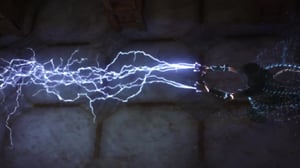
Character FX Artist
Copyright Walt Disney Motion Pictures
TABLE OF CONTENTS
What does a character FX artist do?
Character FX artists build and run simulations for the hair, cloth, skin, and muscles of 3D character assets (humans, animals, monsters, etc.) in response to their environment and how they are animated. It's a specialization of an FX artist. Depending on the project, this can be executed in a stylized or realistic manner. Before creating character effects for film, artists may also be required to research real-life examples, watch reference videos (when possible), and generate multiple concepts.
Simulations include:
- Cloth (clothing and fabric)
- Hair, fur, and feathers
- Muscle, skin, and fat movement
- Rigid body dynamics
Character FX artists are also known as CFX artists or char FX artists.
Character FX job description
Strands of hair floating on the breeze, muscles extending and contracting as someone runs, fur matting together in the pouring rain, a pair of pants crumpling to the floor — these actions (and more!) are the responsibility of a character FX artist.
Role and responsibilities of a CFX artist in visual effects may include:
- Set up and adjust hair, cloth, and fur simulations with direction from the Department Supervisor/Lead using relevant software (see below)
- Complete character FX work on a shot-per-shot basis
- Check for and fix penetration and intersection problems
- Check for and address any continuity issues
- Develop automated workflows for character setups
- Communicate effectively with surrounding departments (animation, modelling, surfacing, and rigging) as needed to continually improve simulations
- Become proficient with all relevant department tools, suggesting improvements and optimizations if/when necessary
- Taking on and executing creative briefs and feedback from Leads and Supervisors to execute assigned tasks and shots
- Ongoing communication with Production and Leads regarding schedules and deadlines
- Ensure all shot assets can be cached to be picked up downstream (in lighting and/or comp)

How much does a CFX artist make?
Wages for FX Artists start at around USD $75,000 and peak at around USD $180,000.
To learn more about this field, visit: What is the Visual Effects Pipeline? or VFX industry advice for junior FX artists
Skills required to become a character FX artist
CFX artists require a mix of technical, creative skills, and interpersonal skills. The VFX industry is a highly collaborative environment — a single shot will often travel through multiple departments before being finaled — so CFX artists must be able to work well in a team and have a solid understanding of the VFX pipeline.
Recruiters may look for the following skills when hiring a character FX artist:
- Houdini experience: setting up and running quality simulations (demonstrated via showreel) and working knowledge of simulation concepts
- Understanding of muscle and skin simulation
- Understanding of anatomy and form in motion
- Ability to work in a fast-paced environment and work under pressure to meet tight deadlines and rapid turnaround times
- A solid understanding of the VFX post-production pipeline
- Highly collaborative and a team player
- Problem-solving abilities with an analytical mindset
- Organized, particularly with asset management (including naming systems)
- Excellent communication skills, both written and verbal
- High-level attention to detail
- Experience making model corrections for shot finalization
- An interest and aptitude for learning new software
What software and tools do character FX artists use?
Character FX artists must know their way around SideFX Houdini but there are other software they should also learn.
Programming languages VEX and Python are also commonly used in FX
Character FX artists may need knowledge of a combination of the following software:

Maya is a comprehensive 3D animation software used for creating detailed models, animations, and visual effects. It's popular in film, TV, and game development for its powerful tools.

Houdini is built from the ground up to be a procedural system that empowers artists to work freely, create multiple iterations and rapidly share workflows with colleagues.

Nuke is a node-based digital compositing and visual effects application first developed by Digital Domain and used for television and film post-production
A day in the life of a character FX artist
If you want to work as a vfx artist, you need to understand every step of the VFX pipeline.
The visual effects production pipeline refers to the various stages of production required to add visual effects to a film or video game. The pipeline organizes each department so that every artist knows their role, and a production can move along within the allocated timeline. The production pipeline differs slightly between film and game production, and roles will vary depending on studio size.
FX artists work in post-production, creating simulated elements and making sure that they are added seamlessly to the footage. VFX artists work alongside animators to integrate effects such as destruction, fire, liquids, smoke, particle simulations, etc.
How to become a Character FX artist
To get a job in VFX, you’ll need an amazing demo reel! Here are some tips to get you started. Don't forget to check out VFX supervisor Jorge Razon's top demo real and interview tips.
- Students, keep your reel < 1 min. If you have 1–2 years experience, < 2 mins.
- Include any production experience you have.
- Breakdowns are good but keep it to 3–4 quick wipes.
- Always Include breakdown descriptions where applicable.
- Use Vimeo— the video quality is better than YouTube.
- Everything in your reel should be 10/10, do not include mediocre work.
- Keep the music fairly conservative, nobody listens to it anyway.
- Watch your reel a lot of times and look for comp, edit, frame or spelling errors.
- Get feedback from at least 3 instructors or industry pros before releasing online.
- Show reference footage when applicable.
- Share your reel with the world via LinkedIn, Facebook, Instagram.
- Include the Houdini procedural workflow (if applicable) to impress recruiters.
Almost all schools train students to become generalists. If you are applying for VFX jobs at a small studio with less than 30 artists, they will most likely want a generalist. Larger studios will have separate departments, so a more specialized set of skills is desirable.

Ready to Start Your Film & Games Journey?
Download our course guide to see how we can help you on your pathway to your dream career.Tips to break into the FX industry
“FX are everywhere in movies, TV, games and advertising... frosty breath, blood splatter, bullet hits, sparks, clouds, ocean extensions and splashes. You may not think the movie you’re watching has many FX, but wait for the end credits.” - Magdalena Bisogni, VFX Producer and Recruiter
Increase your chances of getting hired with these strategies for success:
Download software
Trial VFX programs like Maya, Nuke or Houdini Apprentice.
Build skills
Build the skills companies are listing on job sites. For more support, enroll in a reputable course. CG Spectrum’s FX courses include mentorship from VFX pros and an industry-led curriculum.
Watch trends
Online tutorials, webinars, and events can help keep your skills fresh.
Network
Networking is vital. Familiarize yourself with the industry and build your community. Interact online and in real life with industry pros who might offer advice, insights, or job opportunities.
Intern
Internships at VFX or game studios can help you break into the industry. It’s one way to gain hands-on experience, network, and experience studio life.
Join contests
Practice your skills and create assets for your reel by participating in contests and challenges on sites like The Rookies and ArtStation.
Share work
Social media is great for showcasing work, building an audience, having your work shared by others, and seen by potential clients and collaborators.



